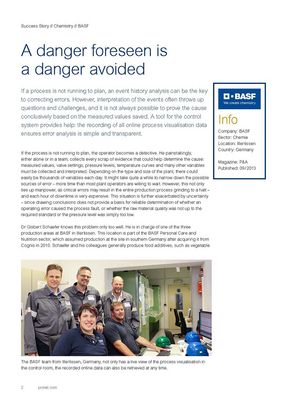If the process is not running to plan, the operator becomes a detective. He painstakingly, either alone or in a team, collects every scrap of evidence that could help determine the cause: measured values, valve settings, pressure levels, temperature curves and many other variables must be collected and interpreted. Depending on the type and size of the plant, there could easily be thousands of variables each day. It might take quite a while to narrow down the possible sources of error – more time than most plant operators are willing to wait. However, this not only ties up manpower, as critical errors may result in the entire production process grinding to a halt – and each hour of downtime is very expensive. This situation is further exacerbated by uncertainty – since drawing conclusions does not provide a basis for reliable determination of whether an operating error caused the process fault, or whether the raw material quality was not up to the required standard or the pressure level was simply too low.
Dr Gisbert Schaefer knows this problem only too well. He is in charge of one of the three production areas at BASF in Illertissen. This location is part of the BASF Personal Care and Nutrition sector, which assumed production at the site in southern Germany after acquiring it from Cognis in 2010. Schaefer and his colleagues generally produce food additives, such as vegetable fat and oil-based emulsifiers. And if anything does not go to plan, Schaefer is delighted that he no longer has to rely on clues to carry out subsequent investigations. “We focus not only on the symptoms but also on the causes,” explains Schaefer.
This is enabled by an inconspicuous add-on of the process control system, which is now used in almost every production area in Illertissen. Plant iT from ProLeiT offers the optional add-on Plant Direct iT Visu-Recorder. As the name suggests, it allows the simple recording of all online process visualization data – at any time and discreetly in the background. The data can then be simply retrieved and displayed via the standard user interface of the control system whenever it is required. It is therefore possible to discover what happened, when and where and who was involved – right down to each individual mouse click. This ensures that plant owners, shift supervisors and operators know what happened directly before a problem occurred instead of having to disentangle the possible causes from the consequences.

